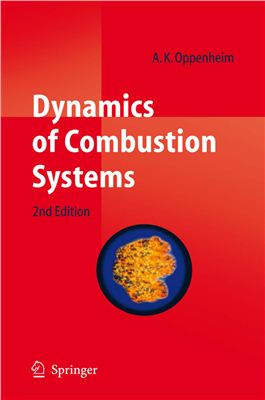2nd ed. Springer, 2008. 368 p. ISBN:3540773630.
Combustion systems are confined fields of compressible fluids where exothermic processes of combustion take place, subject to boundary conditions imposed at its borders. The subject of Dynamics of Combustion Systems is presented in three parts.
Part Exothermicity - considering the thermodynamic effects due to evolution of exothermic energy in a combustion system, it includes:
Chapter Thermodynamic Aspects;
Chapter Evolutionary Aspects;
Chapter Heat Transfer Aspects; and,
Chapter Chemical Kinetic Aspects.
Part - Field - exposing the dynamic properties of flow fields where the exothermic energy is deposited, it contains:
Chapter Aerodynamic Aspects;
Chapter Random Vortex Method;
Chapter Gasdynamic Aspects; and,
Chapter Gasdynamic Fronts.
Part - Explosions - revealing the dynamic features of fields and fronts due to rapid deposition of exothermic energy, it features:
Chapter Blast Wave Theory;
Chapter Self-Similar Solution;
Chapter Phase Space Method; and,
Chapter Detonation.
Combustion systems are confined fields of compressible fluids where exothermic processes of combustion take place, subject to boundary conditions imposed at its borders. The subject of Dynamics of Combustion Systems is presented in three parts.
Part Exothermicity - considering the thermodynamic effects due to evolution of exothermic energy in a combustion system, it includes:
Chapter Thermodynamic Aspects;
Chapter Evolutionary Aspects;
Chapter Heat Transfer Aspects; and,
Chapter Chemical Kinetic Aspects.
Part - Field - exposing the dynamic properties of flow fields where the exothermic energy is deposited, it contains:
Chapter Aerodynamic Aspects;
Chapter Random Vortex Method;
Chapter Gasdynamic Aspects; and,
Chapter Gasdynamic Fronts.
Part - Explosions - revealing the dynamic features of fields and fronts due to rapid deposition of exothermic energy, it features:
Chapter Blast Wave Theory;
Chapter Self-Similar Solution;
Chapter Phase Space Method; and,
Chapter Detonation.

